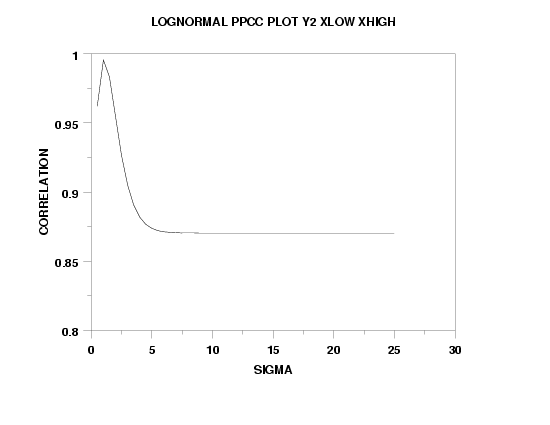

|
COMBINE FREQUENCY TABLEName:
<SUBSET/EXCEPT/FOR qualification> where <y1> is a variable containing the original frequencies; <xmid> is a variable containing the bin mid-points; <y2> is a variable where the combined frequencies are stored; <xlow> is a variable where the lower limits for the combined bins are stored; <xhigh> is a variable where the upper limits for the combined bins are stored; and where the <SUBSET/EXCEPT/FOR qualification> is optional.
before the COMBINE FREQUENCY TABLE command.
PPCC PLOT KS PLOT CHI-SQUARE GOODNESS OF FIT
LET Y = LOGNORMAL RANDOM NUMBERS FOR I = 1 1 100
LET Y1 XMID = BINNED Y
PRINT Y1 XMID
LET Y2 XLOW XHIGH = COMBINE FREQUENCY TABLE Y1 XMID
PRINT Y2 XLOW XHIGH
TITLE AUTOMATIC
Y1LABEL CORRELATION
X1LABEL SIGMA
LOGNORMAL PPCC PLOT Y2 XLOW XHIGH
VARIABLES--Y1 XMID
0.6000000E+01 0.2812552E-01
0.2000000E+02 0.4171193E+00
0.2400000E+02 0.8061130E+00
0.1400000E+02 0.1195107E+01
0.1300000E+02 0.1584100E+01
0.7000000E+01 0.1973094E+01
0.5000000E+01 0.2362088E+01
0.1000000E+01 0.2751082E+01
0.1000000E+01 0.3140075E+01
0.1000000E+01 0.3529069E+01
0.1000000E+01 0.3918063E+01
0.3000000E+01 0.4307056E+01
0.0000000E+00 0.4696051E+01
0.2000000E+01 0.5085044E+01
0.1000000E+01 0.5474038E+01
0.0000000E+00 0.5863031E+01
0.0000000E+00 0.6252026E+01
0.0000000E+00 0.6641019E+01
0.0000000E+00 0.7030013E+01
0.1000000E+01 0.7419006E+01
VARIABLES--Y2 XLOW XHIGH
0.6000000E+01 -0.1663711E+00 0.2226222E+00
0.2000000E+02 0.2226226E+00 0.6116159E+00
0.2400000E+02 0.6116164E+00 0.1000610E+01
0.1400000E+02 0.1000610E+01 0.1389603E+01
0.1300000E+02 0.1389604E+01 0.1778597E+01
0.7000000E+01 0.1778598E+01 0.2167591E+01
0.5000000E+01 0.2167591E+01 0.2556585E+01
0.1100000E+02 0.2556585E+01 0.7613503E+01

Date created: 11/7/2005 |